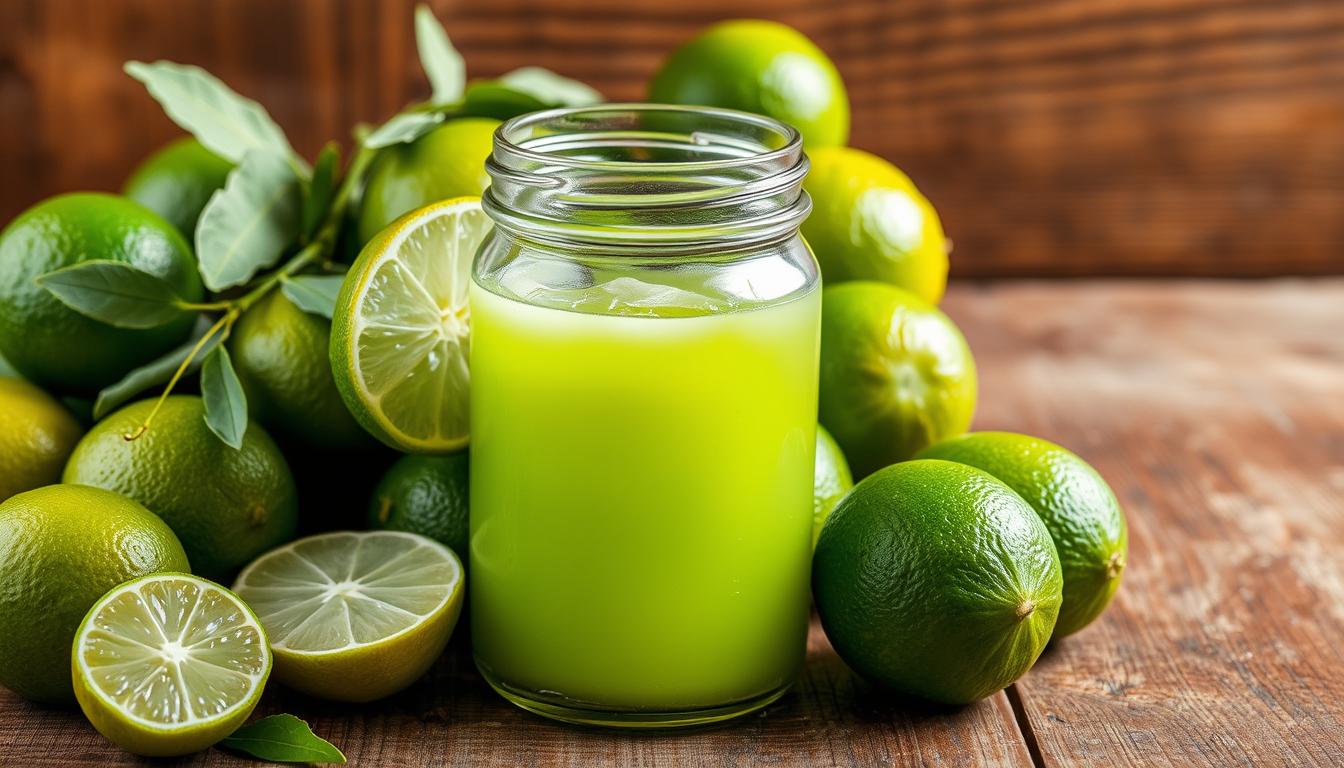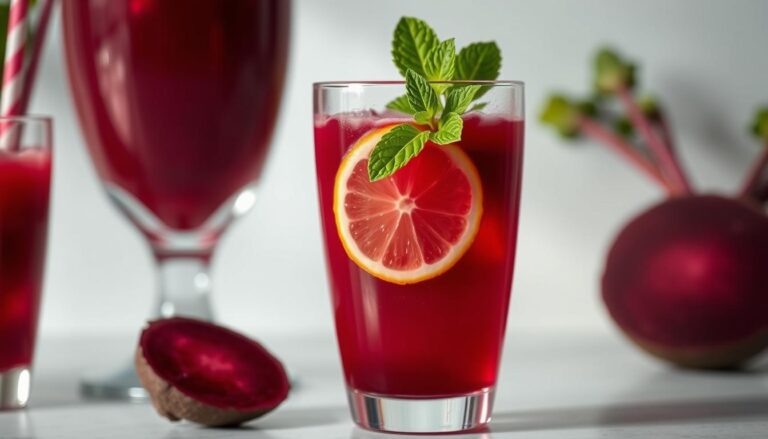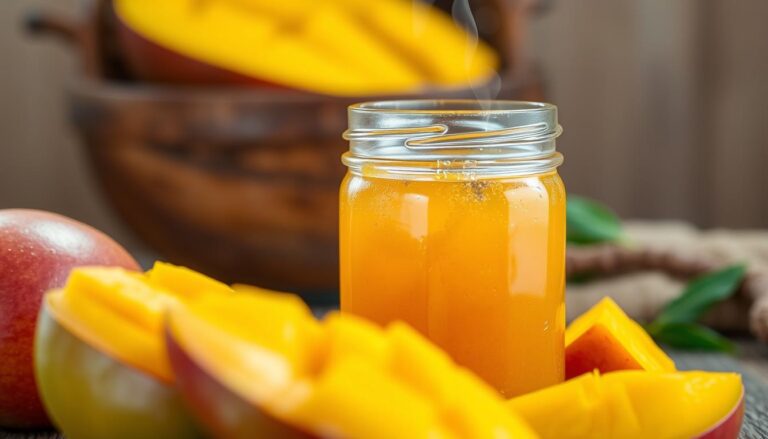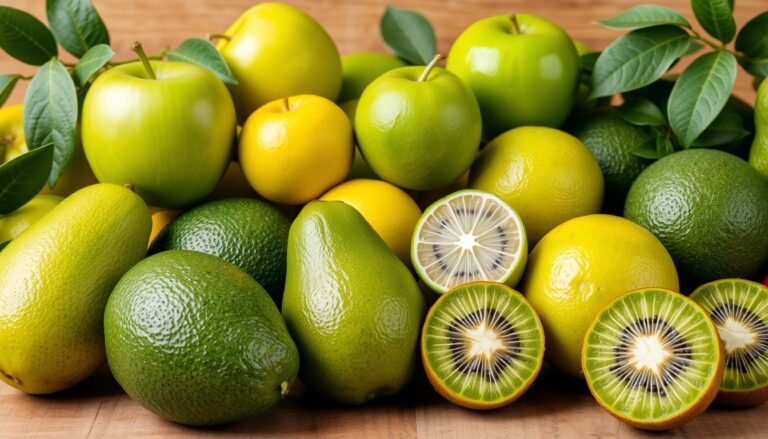Lime Juice: How To Make It Taste Even Better
Unlock the zesty potential of citrus fruits with our ultimate lime juice guide! Whether you’re a cocktail enthusiast or a home cook, mastering lime juice can transform your culinary creations. An average lime yields about 2 tablespoons of fresh juice, packed with vibrant flavor and nutrition.
Dive into the world of lime juice and discover how these small green powerhouses can elevate your dishes and drinks. From understanding juice extraction to maximizing flavor, this guide will help you squeeze every delicious drop from your citrus fruits.
Key Takeaways
- One lime typically produces 2 tablespoons of fresh juice
- Lime juice contains only 10 calories per tablespoon
- Fresh lime juice stays good for 2-3 days in the refrigerator
- Rolling limes before juicing helps maximize juice extraction
- Lime juice is keto-friendly and versatile in cooking
Understanding Fresh Lime Selection
Choosing the right lemon and lime is an art that can elevate your cooking. Not all limes are the same. Knowing how to pick the best ones can greatly affect taste and juice.
Identifying Peak Ripeness
Here’s what to look for in the perfect lime:
- Color should be a lighter green, almost yellow hue
- Smooth skin without bumps or thick texture
- Heavier weight indicates more juice potential
- Strong citrusy scent when gently scratched
Checking for Quality Indicators
Experts say lime quality is crucial in cooking. Persian limes are milder than key limes. A ripe lime is firm but slightly soft when squeezed.
Seasonal Buying Tips
Limes are best from May to September. They don’t ripen after picking.
Pro tip: Pick limes that are heavy and look fresh. Stay away from soft spots, dark marks, or wrinkled skin.
Essential Tools for Juicing
Getting the perfect lime juice is all about the right tools. Both pros and home bartenders agree: the right juicer is key. It boosts flavor and makes the process smoother.
Here are the top tools to take your lime game to the next level:
- Manual Juicers: The Chef’n FreshForce Citrus Juicer is a standout. It’s made of nylon and stainless steel, and comes in three sizes for different fruits.
- Electric Juicers: The Breville citrus press is a pro’s dream. It’s 100 watts and has sensors that start juicing when you put in fruit.
- Compact Options: The OXO Good Grips 2-in-1 Citrus Juicer is ideal for small spaces. It’s light and has a built-in measuring cup.
From simple reamers to electric wonders, juicing tools vary. The Zulay Professional Heavy Duty Citrus Juicer is a favorite among pros. It’s big and powerful, perfect for juicing lots with ease.
Pro tip: Think about what you need before picking a juicer. Manual reamers like the Williams Sonoma one are good for occasional use. But electric juicers, like the Black+Decker, are convenient with their big capacity and pulp control.
With the right tools, lime juicing becomes a breeze!
Lime Juice: Extraction Techniques
Getting the most out of your limes takes skill and the right approach. It’s not just about squeezing. It’s an art that can greatly improve your cooking.
Preparing limes for maximum juice involves several key techniques. Both professional chefs and home cooks swear by them. The secret is knowing how to handle these citrus fruits to unlock their full potential.
Room Temperature Preparation
Limes stored at room temperature are juicier and easier to extract. Pro tip: Keep your limes out of the refrigerator for up to one week before juicing. Warm limes release juice more readily than cold ones.
Rolling Method for Maximum Yield
- Gently roll the lime on a hard surface using firm palm pressure
- Apply consistent, gentle force to break down internal membranes
- Continue rolling for 10-15 seconds before cutting
This technique breaks down the internal structures of acidic ingredients. It makes juice extraction significantly easier. A quick 15-30 second microwave can also help soften the lime and increase juice output.
Proper Cutting Techniques
- Slice limes into thirds instead of halving
- Use a fork to poke the flesh and release more juice
- Squeeze with consistent, gentle pressure
By slicing into thirds, you can extract 100% of the available juice. This method bursts the juice sacs more effectively. Cold press juicing methods can further maximize nutrient retention while extracting every drop of delicious lime juice.
Storage Solutions for Extended Freshness
Proper storage of lime juice is key to keeping its flavor and quality. The right techniques help protect its natural taste. This is crucial for bartenders.

Experts say different storage methods affect the juice’s quality. Here are some top tips for keeping lime juice fresh:
- Refrigeration is your first line of defense for short-term storage
- Fresh lime juice stays good for 3-5 days in the fridge
- Use airtight glass containers to reduce oxidation
- Freezing is a great option for longer storage
For those serious about preserving lime juice, here are some advanced methods:
- Freeze lime juice in ice cube trays – these cubes can last 3-4 months
- Sealed glass jars help prevent contamination
- Keep it in the coldest part of your fridge
- Limit exposure to light and air
Watch for signs of spoilage: bad smells, color changes, or odd tastes mean it’s gone bad. By using these storage tips, your lime juice will stay fresh for your next cocktail.
The Science of Flavor Enhancement
Unlocking the secret to perfect lime juice isn’t just about squeezing fruit—it’s a delicate dance of scientific precision. Acidic ingredients play a crucial role in transforming ordinary dishes into culinary masterpieces. Understanding the intricate chemistry behind flavor can elevate your cooking from good to extraordinary.
Professional flavorists work with an incredible palette of over 8,000 different ingredients to craft sensational taste experiences. Their expertise reveals how acidic ingredients like lime juice can dramatically impact flavor profiles.
Understanding Acidity Levels
Your taste buds detect acidity through a complex process involving five primary taste categories. Lime juice’s unique acidic properties can:
- Balance saltiness in dishes
- Round out flavor notes
- Stimulate multiple taste receptors
Balancing Sweet and Sour Notes
Creating perfect flavor harmony requires understanding how acidic ingredients interact. The human tongue can detect subtle variations in taste, making precision crucial.
| Flavor Component | Impact on Taste |
|---|---|
| Acidity | Brightens and sharpens flavor |
| Sweetness | Softens and balances tartness |
| Umami | Adds depth and complexity |
Temperature Impact on Taste
Temperature dramatically influences how we perceive acidic ingredients. Chilled lime juice tends to taste sharper, while room temperature juice offers a more nuanced flavor profile. Experimenting with temperature can unlock exciting taste dimensions in your culinary creations.
Mixing Perfect Combinations
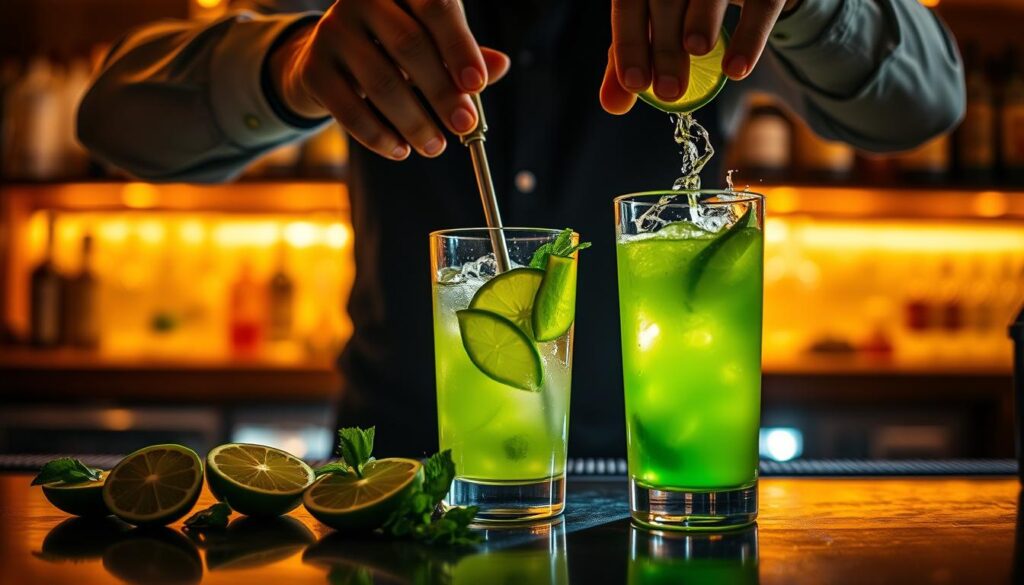
Discover the magic of lime juice in your cooking and mixing. It turns your margarita mixer into a flavor explosion. Fresh lime juice makes your cocktails and dishes pop with flavor, impressing everyone.
Here are key tips for the perfect cocktail garnish:
- Use 2 ounces of fresh lime juice for maximum flavor intensity
- Balance your margarita with 2 ounces of silver tequila
- Add 1 ounce of agave nectar for subtle sweetness
- Include 1/2 ounce of Cointreau for depth
Shake your margarita mixer hard for 30 seconds. This makes it icy and frothy, improving the drink’s feel. Chill your glasses in the freezer for 30 minutes to keep drinks cool.
Want to try something new? Here are some unique ideas:
- Spicy Jalapeño Margarita: Add thin jalapeño slices for a kick
- Fruit Fusion: Substitute lime with grapefruit or cranberry juice
- Herbal Twist: Muddle fresh mint leaves for added complexity
Experts say to rim your glass with coarse salt. It boosts the drink’s look and taste. With these tips, you’ll become a pro at home, making drinks that everyone will remember.
Common Mistakes to Avoid
Making the perfect lime juice is more than just squeezing fruit. Even skilled cooks can make mistakes with tropical produce. Knowing these common errors can improve your cooking and avoid bad results.
Temperature Control Challenges
Temperature is key to keeping lime juice fresh. Too hot or too cold can change its taste and nutrients. Your juice is most at risk when the temperature is not steady.
- Keep lime juice between 40-45°F for optimal preservation
- Avoid storing tropical produce juices at room temperature for extended periods
- Chill juice rapidly to maintain enzyme activity
Storage Missteps
Storing your tropical produce juice wrong can ruin it. Fresh lime juice loses its taste and nutrients if not stored right.
- Consume fresh juice within 15 minutes for maximum nutrient retention
- Use airtight containers when refrigerating
- Limit storage time to 24-36 hours for best quality
Mixing Technique Errors
Adding lime juice too soon can make your dish bitter. The right time and method are key when using this zesty ingredient.
- Add lime juice near the end of cooking
- Avoid overcooking to prevent flavor degradation
- Balance acidity with complementary ingredients
Pro tip: Always taste and adjust your recipe gradually when using lime juice to achieve the perfect flavor profile.
Creative Culinary Applications
Discover the magic of lime juice in your kitchen. It opens up new culinary adventures beyond the usual. Mexican and Caribbean flavors bring a burst of life to your dishes, making them unforgettable.
Here are some ways to use lime juice in your cooking:
- Create zesty marinades for grilled meats and seafood
- Craft refreshing tropical cocktails with a lime juice base
- Develop unique salad dressings with Caribbean flavor profiles
- Experiment with lime-infused desserts
Mexican cuisine is a perfect match for lime juice. Use it in ceviche to “cook” raw fish. Or add it to salsas and guacamole for a fresh twist. Caribbean flavors also love lime, using it in vibrant sauces and marinades.
With lime juice, your cooking can reach new heights. It’s great for both sweet and savory dishes. Let lime juice be your secret ingredient in the kitchen.
Health Benefits and Nutrition
Lime juice is more than just a flavor booster. It’s a treasure trove of nutrients that can boost your health. These small fruits pack a big punch of essential nutrients.
Vitamin C Powerhouse
One lime gives you about 22% of your daily Vitamin C. This vitamin is key for:
- Boosting your immune system
- Helping your body absorb iron
- Keeping your skin healthy
- Fighting off colds
Antioxidant Protection
Limes are full of flavonoids, which are antioxidants. These protect your cells and may lower inflammation. Studies show they might also:
- Lower stroke risk
- Keep your heart healthy
- Make you less likely to get infections
Digestive Wellness
Lime juice is good for your digestion. It has only 20 calories and lots of citric acid. This can help with:
- Improving digestion
- Lowering the risk of kidney stones
- Supporting good gut bacteria
Pro tip: Add fresh lime juice to your meals for a tasty way to get more nutrients!
Substitutions and Alternatives
Running out of lime can be frustrating when you’re in the middle of cooking. Luckily, there are several alternatives that can save your recipe. These substitutes offer similar tangy flavors, helping you keep your dishes balanced.
Citrus fruits are the closest replacements for lime juice. Lemons are a perfect 1:1 substitute, offering a similar acidic profile. Grapefruit and orange juices can also work, but they add unique flavor notes to your recipe.
Top Lime Juice Substitutes
- Lemon juice (1:1 replacement)
- Grapefruit juice (1:1 replacement)
- Orange juice (1:1 replacement, slightly sweeter)
- Vinegar alternatives
When fresh citrus isn’t available, consider these dry ingredient alternatives:
| Substitute | Replacement Ratio | Best Used In |
|---|---|---|
| Citric Acid | Small pinch | Concentrated flavor recipes |
| Cream of Tartar | 1/2 teaspoon per tablespoon | Baking and marinades |
| Amchur Powder | 1 teaspoon per 3 tablespoons | Indian and Asian cuisine |
Pro tip: When using dry ingredients or vinegar substitutes, adjust the liquid content in your recipe. White wine vinegar has a milder tang than apple cider vinegar. This makes it a more versatile lime juice alternative.
Remember, while these substitutes are good, nothing beats the fresh, bright flavor of real lime juice. Experiment and find what works best for your specific recipe!
Conclusion
Your lime juice adventure is just starting! It’s not just for tacos or cocktails. You’ve learned how to pick, squeeze, and keep lime juice fresh. This will change how you cook and drink.
Lime juice is super versatile. You can use it in salad dressings or add flavor to your favorite dishes. The skills you’ve learned will make your cooking and drinks better. Every lime can make your food taste amazing.
Using lime juice is all about being creative and enjoying flavors. You know how to choose the best limes, get the most juice, and store it right. This knowledge lets you use lime juice in new and exciting ways.
Learning about lime juice is a journey that never ends. Keep trying new things and tasting different flavors. Your taste buds will love the adventures you’ll have!
FAQ
How do I choose the best limes for juicing?
What’s the best tool for juicing limes?
How can I get more juice from my limes?
How long can I store fresh lime juice?
Are there health benefits to drinking lime juice?
What can I use if I don’t have lime juice?
How does temperature affect lime juice flavor?
Can I use lime juice in more than just cocktails?
Source Links
- How to Juice a Lime (6 Methods With + Without Juicer | + Freeze it) – https://www.alphafoodie.com/how-to-juice-a-lime/
- How to Clarify Lime Juice • A Bar Above – https://abarabove.com/clarified-juice/
- How To Choose The Best Limes At The Grocery Store – https://www.thetakeout.com/1705707/grocery-store-limes-best-choice/
- All about Fresh Lime Juice – https://barfruitdelivery.co.uk/blogs/blog/all-about-lime-juice?srsltid=AfmBOopS80uNLIRM60j9dVyEIT7HWLmC9oINAhneEoXEMop_PmQglRD_
- When Life Hands You Lemons, Use These Citrus Juicers to Make Lemonade – https://www.thespruceeats.com/best-citrus-juicers-4843483
- Squeeze the Most Out of Citrus Season With These 5 Citrus Juicers That Aced Our Tests – https://www.foodandwine.com/lifestyle/kitchen/best-citrus-juicers
- The Best Citrus Juicer – https://www.nytimes.com/wirecutter/reviews/best-citrus-juicer/
- Squeeze The Most Juice Out Of Dry Limes With A Simple Fork Trick – https://www.yahoo.com/lifestyle/squeeze-most-juice-dry-limes-231552994.html
- Juicing Lime For Health And Nutrition With A Juicer – Froothie Australia – https://froothie.com.au/blogs/articles/juicing-lime?srsltid=AfmBOopDxLYv_QRfEY6467g2KOCMvR5FtFrYSUOJ5c0wx7AlW9GNUBOp
- How Long Does Lime Juice Last In The Fridge? | Fridge.com – https://fridge.com/blogs/news/how-long-does-lime-juice-last-in-the-fridge?srsltid=AfmBOopaweYB1VuRzX9v5kaZmKCkAs4VGDs7R8OEMK5jlbfOIXyThaz3
- 12 Simple Tips to Keep Your Produce Fresh for Longer – https://hauslane.com/blogs/resources/12-simple-tips-to-keep-your-produce-fresh-for-longer?srsltid=AfmBOoqmPd2QmYFEW1PYdmKSWz7hzHeJJsuDI13LFRh7CPGwOCm0EUoQ
- 5 Ways To Store Lemons So They Stay Fresh Longer – https://www.southernliving.com/food/fruits/citrus/lemon/how-to-store-lemons?srsltid=AfmBOoqTQzFUep6ny0lXN7I0_lLBKqAO9VPmJu71VmD5l8_k_iuy-GtA
- How You Can Taste Food Like A Flavor Chemist – https://www.sporkful.com/how-you-can-taste-food-like-a-flavor-chemist/
- How Flavor Profiles Are Created in Food and Beverage Industries – Trilogy Flavors – https://trilogyflavors.com/how-flavor-profiles-are-created-in-food-and-beverage-industries/
- How Taste Sensation Affects Flavor Development – Trilogy Flavors – https://trilogyflavors.com/how-taste-sensation-affects-flavor-development/
- Homemade Margarita Mix – https://abeautifulmess.com/homemade-margarita-mix/
- Mojitarita Lime and Tequila Cocktail – Familystyle Food – https://familystylefood.com/tequila-lime-mojitorita-cocktail/
- I’ve Tried Countless Margarita Recipes, and This Is Hands-Down the Best – https://camillestyles.com/food/this-classic-margarita-recipe-never-fails-me/
- Are You Making These Common Juicing Mistakes? + Recipe – https://foodbabe.com/juicing-mistakes/
- Juicing Mistakes and Expert Tips for Maximum Nutrition & Safety – Juicing and Plant Based Diet Health Coach Stephanie Leach – https://stephanieleach.com/2025/01/31/juicing-mistakes-and-expert-tips-for-maximum-nutrition-safety/
- Margarita Burn: The unknown danger of mixing lime juice with sunlight | North Shore Mums – https://www.northshoremums.com.au/margarita-burn-the-unknown-danger-of-mixing-lime-juice-with-sunlight/
- Finger Limes: Unveiling the Citrus Caviar of Gourmet Cuisine – https://www.gourmetorchards.com/finger-limes-unveiling-the-citrus-caviar-of-gourmet-cuisine/
- What Can’t They Do? 9 Helpful Uses for Limes – https://www.morninghoney.com/p/helpful-uses-limes
- 14 Creative Key Lime Recipes For Popsicles, Cocktails, Cakes, & More – https://www.delish.com/cooking/recipe-ideas/g60724579/key-lime-recipes/
- Health Benefits of Limes – https://www.webmd.com/diet/health-benefits-limes
- 5 Ways Limes Can Zest Up Your Health – https://www.health.com/lime-benefits-8628997
- What Are the Best Substitutes for Lime Juice? – Insider’s Kitchen – https://insiderskitchen.com/what-are-the-best-substitutes-for-lime-juice/
- 5 Substitutes for Lime Juice from a Chef – JackSlobodian – https://jackslobodian.com/lime-juice-substitutes/

